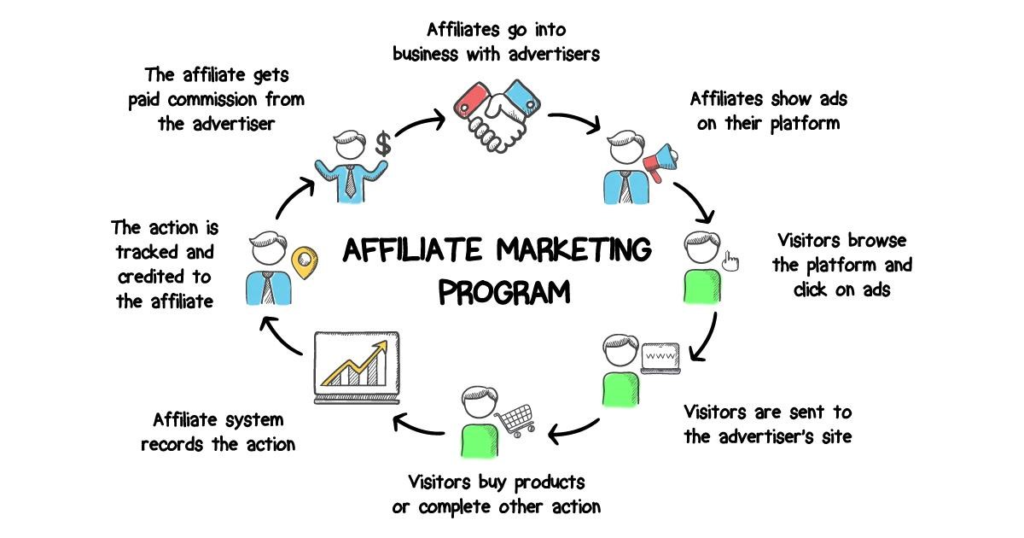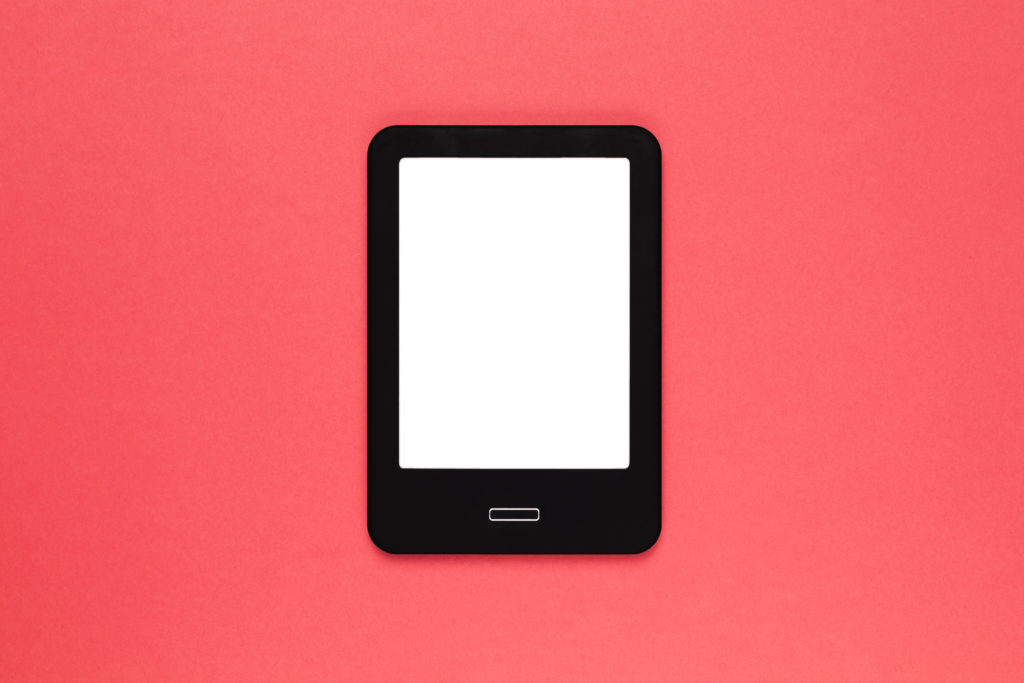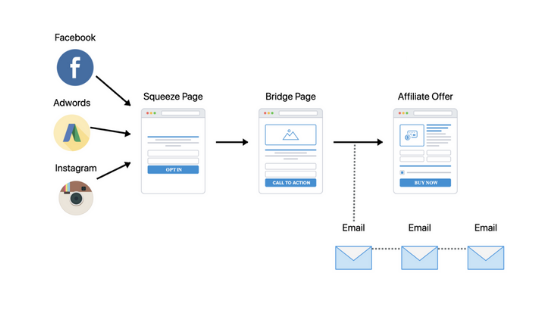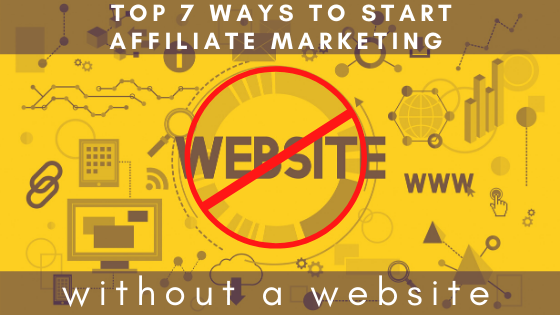If you have made it to this post, chances are you are interested in starting your very own affiliate marketing business. If that’s the case, then I want to congratulate you on making such a wise decision.
Affiliate marketing is perhaps one of the best business models for those who wish to make money online and obtain a passive income. If done correctly, affiliate marketing can also be the gateway to financial freedom, allowing you to work from virtually anywhere.
However, you will find that most people recommend you create a website or blog when starting your affiliate marketing business.
Even in my step-by-step guide to affiliate marketing, I provide my methods on how to begin affiliate marketing, focused on the idea of creating a website.
But, can you start affiliate marketing without a website?
The short answer is Yes.
You don’t need a website or blog to succeed as an affiliate marketer, and if you stick with me through this post, I will provide you with my top 7 ways to start affiliate marketing without a website.
How Does Affiliate Marketing Work?
Before we dive into the different ways you can begin affiliate marketing without a website, let’s take a quick look at how affiliate marketing works.
The affiliate marketing equation typically involves four main parties:
- The affiliate
- The merchant (or seller)
- The customer
- The Affiliate Network

So, how does this equation come together? The affiliate (you), who is interested in promoting a product browses a platform known as an affiliate network.
The affiliate network works as an intermediary between the affiliate and the merchant. It also serves as a database for products, where the affiliate marketer can choose which to promote.
Once an affiliate finds a merchant’s product they wish to promote, they receive a personalized affiliate link.
This link has a special code that notifies the merchant every time a customer clicks on it and is sent to their website. If a customer happens to purchase the product you are promoting then you get a commission of the sale.
Your affiliate link is the primary factor in the equation. It can be placed virtually anywhere online, as long as you are not spamming it across the internet.
As long as customers are purchasing products through your affiliate links, you can be profitable. No requirement says a website has to be used.
Now, I will show you different ways to promote your link so you can still be successful with affiliate marketing.
7 Ways To Start Affiliate Marketing Without A Website
1.Posting Links in Forums

A great way to start affiliate marketing without a website is by leveraging the power of internet forums.
Internet forums are online communities where like-minded people come together. These can be great places to promote your affiliate products, as long as you join forums that relate to your product or niche.
Be aware, however, that some forums disagree with promoting your affiliate links. They consider it spamming and have been known to ban users who try to do it.
It is always good practice to check the forum guidelines to make sure they allow affiliate links before you begin posting.
Even if a forum does allow affiliate links, you should always make sure your post and comments provide value. Also, You want your content to be deemed useful, relevant, and interesting to those within the forum community.
This is important because proving useful information helps you become an authority in your niche.
When you are seen as an authority, you gain the respect of other users and you are more likely to attract visitors to your content and, therefore, potentially get clicks to your affiliate products.
A good example of a forum to join is Quora. There you will find thousands of questions from other people, on your niche. Before you start promoting your products, I recommend you answer other people’s questions regularly to build a relationship and establish trust with your audience.
Over time people will trust you and will be happy to click on the links you have provided.
2. Create an ebook

This next method of affiliate marketing without a website requires a lot of work on your part, at least on the front end. Ebooks in the past few years have become a popular way of sharing information.
You can take advantage of this by creating your very own ebook on a hot topic on your niche.
For this method to work you will need to conduct comprehensive research to find a topic people want to read about and invest a lot of time to create quality content.
A good way of finding what is trending in your niche is by using Google Trends to find topics and questions your audience most frequently search. Typically, the higher the search volume a search receives, the more interested people are in that said topic.
Once you find what you want to write about, construct a 10-15 page ebook that provides a wealth of information and embed your affiliate links within it.
Just like when posting in forums, you should aim to provide value within the book and recommend products that solve your readers’ problems.
Do not just add affiliate links for the sake of adding links.
If you focus on providing value first, People will appreciate that and will be more than likely to trust your recommendation and click on your affiliate links.
If writing isn’t necessarily one of your strong suits, you can always use a freelancing website like Fiverr and have someone write an ebook for you.
The benefit of this method is you can offer your ebook for free or you can charge a price for it. If you do decide to charge for it, having customers click your links within your ebook will simply be a bonus.
3. Start a YouTube Channel

Have you ever watch a YouTube video where the person asks you “to click the link in the description” or have you ever watched a product review/unboxing video. These are examples of affiliate marketing through YouTube and it can be extremely profitable.
Behind Google, YouTube is the second-largest search engine in the world, making it a great place to earn affiliate commissions without a website.
With that being said, you still want to make sure you perform keyword research for your videos because it gives you the potential to have your content display on the YouTube carousel on the first page of the Google search results.
And although keyword research is important, none of that matters if your content isn’t interesting or your video quality is poor.
With YouTube, you need to build a pretty hefty subscriber base if you want to be truly successful, but this all depends on how people connect with your content. Create video content that gets you traffic!
Now, the major drawback of using YouTube as your affiliate marketing platform is that there is always the potential for your channel to get terminated.
YouTube moderators have the power to terminate channels if they even mistakenly think you’ve done anything wrong.
This means if your channel is flagged for any reason, you can lose your whole channel and therefore, your entire affiliate marketing income in a second.
This doesn’t happen too often but to avoid this disaster, focus on producing original content that is appropriate for your viewers.
4. Solo Ads

Solo ads are another method affiliate marketers use to promote their products without a website. If used properly, solo ads can be a very lucrative business model that yields high returns.
But first, what are solo ads? A solo ad is a type of email advertisement where you pay someone to use their email list to promote your affiliate offer.
Say, for example, you are promoting an affiliate product in internet marketing/ make money online niche and you contact an influencer who has a huge presence within that niche. You can ask for them to send out an email on your behalf, promoting your affiliate offer.
Because the influencer is in the internet marketing/ making money online niche also, you know your email will be sent to people who are interested in your products.
In other words, the traffic you receive in return is highly targeted and more likely to convert.
This is what makes solo ads so popular and profitable. Out of all the methods, solo ads have the greatest potential of yielding instant commission.
With that being said, solo ads can still be a bit tricky because not all solo ads providers are equal. The real task is finding ad lenders who send high-quality traffic to your offers. Some, will, unfortunately, send poor quality traffic or fake click to your offer that does not convert.
A good place to start searching for reputable solo ad sellers is at a solo ad network. Udimi is perhaps the most popular ad network where advertisers and publishers can trade specifically for solo ads.
Currently, there is no other major network similar to Udimi where any individuals are free to join.
Because You will be dealing with the solo ad sellers directly it is crucial to make sure you are spending your money on the right person.
Make sure to read reviews about the sellers to get a sense of how trustworthy they are. Before you choose your seller it’s also good practice to Join the seller’s email list. Doing so is like performing undercover research. You’ll want to analyze things like email quality, product quality, and email frequency.
This will give you a fair idea of the quality of clicks that your own offers will receive.
Sellers to avoid are those that send multiple emails in a day to their list. Although it might sound ideal, if a seller sends 2 to 3 emails a day to his list, odds are they are using their list strictly for solo ads, and therefore your email will be ignored by his list.
Choose a solo ad seller who sends emails periodically throughout the week, without spamming their inbox.
Once you find a solo ads seller that brings you a good return on your investment, keep going back to them over and over again with different niche related offers.
5. Social Media

Social media can be an excellent channel to succeed in affiliate marketing without a website. But I would be lying if I told you it will be easy.
Although social media platforms are a great way to promote your affiliate offers, you will need a large following base to see huge results.
You will have to invest time in building your audience to see high engagement when you promote your affiliate offers. However, be aware that some platforms like Instagram don’t allow you to direct links in your post. When creating posts promoting your offer, instruct users to check out the ”link in bio.”
As always, focus on creating good content. Post that get lots of feedback, likes, and shares, will definitely help grow your following.
Having said that, I know this method can take some time before you see results. Here are two other ways to use social media to your favor:
Influencer Marketing:
Influencer Marketing involves the same concept as solo ads. You can pay large influencers (like Instagrammers) to promote your products to their followers. Once again, you want to make sure the influencer is someone related to your niche.
Most Instagrammers with a large follower base, leave their emails in their bio for business inquiries. Try reaching out to them and find out if they would be interested in your affiliate offer.
This method can work exceptionally well because people are more willing to purchase a product that is being recommended by a trustworthy source.
Facebook Groups:
Another great way to promote affiliate products through social media is by harnessing the power of Facebook groups. A Facebook group, like forums, allows people with similar interests to come to a central place to discuss a particular topic.
With Facebook groups, you also have the option of joining a group in your niche or simply starting your own group. Businesses do this all the time, using Facebook groups to interact with their customers, inform about their products, promote affiliate products, or even post relevant industry updates.
As an affiliate marketer, this can help you promote your products while creating a community around them.
This is a good way to portray your expertise and offer value to your group. Doing so will help you build a loyal following, one that keeps people coming back to you.
6. PPC Advertisement

In terms of how quickly you can see results, pay-per-click advertising is probably the fastest way to convert traffic into buyers.
However, this form of paid advertising can come at an extreme price to affiliates who don’t know what they are doing.
When you direct link to your affiliate product through PPC advertisements you are likely to lose a lot more money than you make.
Why?
Because, when you are an affiliate using PPC advertising, you are likely directing traffic directly to the merchants landing page. These pages often provide a large bounce back rate because they are unattractive or of low quality.
Imagine you are a customer searching on the internet and you click an ad, either purposely or by mistake, and you are immediately offered a product to buy.
You are likely to click back out because of how abruptly you were approached or you simply aren’t in the mind frame to buy.
If you are using an advertising platform like Google Ads they take the ads landing page and the customer’s experience into consideration.
For poor experiences, your ad will get assigned a low-quality score which means you will end up paying more for your paid ads.
Even more, if the content of your ad (this includes the merchant’s landing page) violates any of Google’s advertising policies, your account can get suspended. Google and Facebook both have been known to have strict rules when it comes to compliance.
As the affiliate, you have no control over the merchant’s landing page so there is no way to circumvent this issue without the use of your website or personal landing page.

For the PPC method to work, you will need to create a squeeze (or lead) page for your customers to land on before they are directed to the merchant’s page.
With a squeeze page, you can collect the viewer’s email so if they don’t buy your product on the first run, you can then follow up with them by email to remind them of the product.
This way does require a few other tools to ensure that you get the highest conversions. You’ll need:
- A lead capture page builder
Although not quite a website, a squeeze page is designed to capture opt-in email addresses from potential subscribers. Unfortunately, these pages don’t build themselves, so you will have to use a page builder. There are higher-end drag and drop builders like ClickFunnels or more affordable options like Leadpages. Both programs provide templates for you to use, making page building that much more simple.
- Email Autoresponder
Along with your page builder, you will need software that automatically captures and emails potential customers. Luckily most page builders have autoresponders built into the platform already so using an autoresponder is merely a matter of setting it up.
When considering PPC, I ask you to do so with caution. Although it provides the opportunity for instant traffic and commission, you need to know what you are doing.
If you aren’t willing to spend money on your own website then you definitely won’t be willing to pay the amount it takes to run a profitable ad campaign.
7. Email marketing
Notice how I mentioned for you to be successful with PPC, you need to capture viewers emails in case they don’t purchase. Well, believe it or not, this act of capturing emails is its own form of marketing all by itself, and it’s a valuable one at that.
Email marketing is perhaps the best tool when it comes to affiliate marketing with or without a website. The crazy part is it all balls down to one key asset, your email list.
The first step of email marketing is building up a list of subscribers that are interested in hearing from you and then recommending them products.
So how do you build an email list?
You have two options when building your email list: build it yourself or simply buy one.
Yet, I would strongly encourage you to build your list because a purchased list will likely leave you disappointed.
To get people to provide you with their email addresses, you will have to offer them something in exchange, usually something with value. This item of value is what we call a lead magnet and can be anything from a free guide to a free course or resource.
Because you won’t be using a website, you will need a place for people to go to input their email and receive your offer. Once again, this is where page building software becomes so useful. Page builders like Leadpages also include simple form builders as well.

After you’ve built your form and created your offer, you need to direct traffic to your sign up form. You can do this through free methods such as posting on social media or you can even use paid advertisements if you want to speed up the process.
Once you have gathered enough email subscribers you can send out emails weekly promoting your affiliate offers.
Now, I know the process of email marketing is pretty straightforward, but don’t underestimate the importance of writing a good email copy.
If you are going to succeed at email marketing, you’ll need to be a strong copywriter. Like all the other methods we’ve talked about today, your main goal should be to provide valuable and helpful information to your email list. You’ll want to pack in as much value as possible, providing all the necessary information to convince your audience to purchase your offers.
And even after you convert people into buyers, you will still have to work non-stop to keep your email list engaged, while also building the size of your subscriber list.
This can quickly turn into a full-time job but luckily there are tools available that automate this entire process.
Remember the autoresponder I mentioned above? This is the way you truly put your email marketing on cruise control. As long as you create enough email copies, in the beginning, you can schedule them to be sent to your subscribers automatically over some time. This is known as a drip-email campaign and its a potent marketing strategy.
If you want to find out more about how to build an email list in-depth, you can read my blog on it.
So can you start affiliate marketing without a website?
After reading this post, I hope you now realize that it is completely possible to start affiliate marketing without a website. There are plenty of ways of doing it, seven of which we covered today.
I reiterated the importance of providing value several times in this post because it is vital if you ever hope to get offers to your affiliate products.
With all things considered, I want you to understand that, although you are not required to build a website, having one will help you tremendously in your affiliate marketing journey.
When you create an affiliate website, you are building a business that is your own, one that can become an asset over time.
You will also find that when you sign up for most affiliate programs, they will want to see an online place that explains how you will promote their business, therefore, having at least a one-page website is always better than having none at all.
Before you completely shut out the idea of creating a website, I ask you to read my step-by-step affiliate marketing guide, where I explain how to start affiliate marketing with a website.
As always, your comments and suggestions for future posts are welcomed.
Until then, keep hustling.


